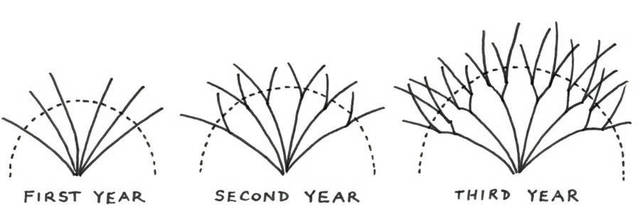
: This diagram shows the best way to shear young shrubs, so they’ll have thicker branching and more blooms. (Illustration by Marjorie Boehme)
Regular shearing, particularly when shrubs are young, helps them develop a stronger branch structure and a more rounded, full, and neat appearance. The more branches they have, the shorter each branch will be, making shrubs more compact and well-shaped in later life.
The best time to shear or trim evergreen shrubs like holly, boxwood and yew is between late fall and early spring. In the dormant season they won’t grow new shoots, so you don’t have to worry about winter burn on tender new growth. Winter burn happens when shrubs are sheared after mid-summer, because new growth doesn’t have a chance to harden off before winter.
Most flowering shrubs should be sheared back when they have no leaves, with a few exceptions. It’s a shame to wait too long and cut off brand-new shoots. Plants that carry their flower buds through the winter, like lilacs and forsythia, are the exceptions and should only be sheared just after they bloom each spring, or you’ll cut the bloom buds off and they won’t bloom until next year.
There’s a right way and a wrong way to shear or trim shrubs. Whether you like them in tidyand neat geometric shapes or want them to look less formal but still well-groomed, there are certain rules you should follow.
First, the shape you select should be widest at the bottom. This is so that sunlight can reach the entire plant for as many hours as possible for best foliage and bloom. If you undercut your shrubs you create shadows where the plants cast shade on themselves, and they will get spindly and thin at the bottom. We like a mounding or “gumdrop” shape best. It looks natural because most shrubs naturally grow wider at the base and narrower at the top, like a pyramid.
Suckering, colonizing shrubs like forsythia don’t look good sheared into shapes, and will not bloom nearly as well. They naturally grow shoots in every direction like a fountain. You can encourage this informal fountain shape by deep-down cutting this type of shrub, forcing it to sucker from the base of the plant as well as from the cuts. The more new shoots, the morerounded and graceful the plant will appear when it grows back. We call this the “bush-hog: approach” or “tough love”. It works particularly well for renewing gnarly old lilacs and redbuds, because it forces the plant to replace old rotten stems with fresh new ones.
Another rule is to cut back each year to just above last year’s cut. Each time you cut a branch the plant forms a fork, doubling or tripling the number of branches. This makes the plant fuller and fluffier, and doubles the number of blooms. If you are afraid to shear back far enough, the plant will get gangly and misshapen. If you shear back too far, cutting last year’s forks off, the plant can be damaged and have bare spots or long suckers.
Naturally mounding flowering shrubs like spirea, potentilla, viburnum, and barberry bloom on their new growth and will bloom more heavily if they are sheared back. Each time your shear, you’ll double or triple the number of blooms in the upcoming season. Nurseries call this technique “shearing back to a flush”. Butterfly bushes, crape myrtle and shrub roses (like Knockout) should be left alone until theystart to sprout in spring, and then cut back hard to the healthiest new shoots. Cutting them in fall or winter invites winter burn, and can even kill butterfly bushes. At best you’ll have a lot of winter kill and have to trim them a second time in early spring.
One other point is that once evergreen shrubs get big enough to crowd each other you should let them join into an “informal hedge”, rather than maintaining a gap between each plant. Narrow gaps don’t let enough sun in, so you’ll wind up with bare spots for your trouble. It’s easier and more attractive to let the plants grow into each other and just shear the outside.
Steve Boehme is a landscape designer/installer specializing in landscape “makeovers”. “Let’s Grow” is published weekly; column archives are on the “Garden Advice” page at www.goodseedfarm.com. For more information is available at www.goodseedfarm.com or call GoodSeed Farm Landscapes at (937) 587-7021.




